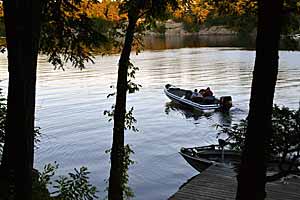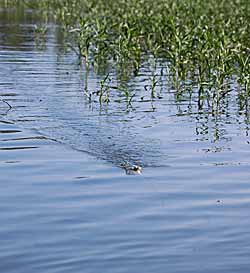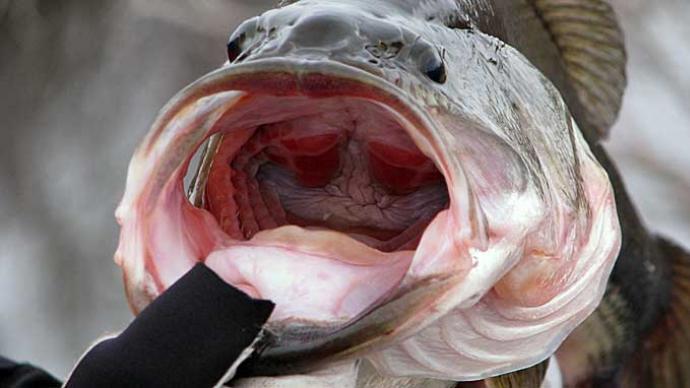
A bass is a bass regardless of where it swims — an impoundment in the South, a bowl-shaped natural lake in the North, or a hawg-filled one in the West. Anglers have spun that yarn for years. They use it to explain why techniques, lures, and patterns are successful in different lakes. But is it true? Are all bass the same? Like all time-tested sayings, there is some truth in this one. But it leaves out an important fact: bass are conditioned and controlled by their environment. Understanding how to read those controlling factors and being versatile enough to select the best bait and present it in the best spot each day are essential to consistent fishing success.
Every largemouth bass has the same biological build. They have big mouths up front and powerful tails out back. Smallmouths and spotted bass do, too. The three species have developed some differences due to their preferred habitat.
Smallies, for example, have strong, pointed jaws that help them pluck crawfish from rocky crevices. The coloration of bass to match their environment, such as the weed-green sides of largemouth, are different, too. Those are intelligent adaptations, but the bass don’t know it. Florida biologists calculated that bass brains are less than .5% of each fish’s weight. Compare that with a human brain, which is more than 2.25%. That much brain lets humans calculate their best moves by observing their environment.
If snow is in the forecast, you know to stock firewood and make chowder after visiting the grocery store for a can or two of clams. Bass, on the other hand, react. So on that same cold day, when you enjoy a fire, are bass seeking rocks, which might radiate heat into the water around them? No. The more likely explanation is that rock-dwelling bass have a slightly bigger strike zone because the water is slightly warmer than where other bass are swimming. The immediate conditions caused a reaction — warmer water made them more willing to bite. Something bigger put them on those rocks in the first place.
Bass react to daily changes such as weather, light, and baitfish movements. They also are forced by environmental queues through seasonal movements, moving shallow to spawn in spring, deep to find food in summer, shallow to gorge on shad in autumn, and deep to vertical structure in winter. Seasonal movements determine where most of the bass will be — you’ll always find those oddballs who stay shallow in winter — and daily conditions will determine how willing they bite and where you’ll find them in those locations. Knowing how each pushes and pulls bass is the first step toward consistently catching bass. The next step is being versatile enough to change with them. Successful anglers simultaneously surf seasonal movements and daily conditions, matching location with technique to stay with the bass. You can stand with those anglers by being versatile.
Success comes by adjusting location and technique to match conditions and movements on any particular day. That sweet spot is always moving. The world is a beautiful place where you call your shots when you find it. Thoughts of your bass boat festooned with for-sale signs come easy when you can’t find it. For example, if you love to flip, you’ll have good times on sunny spring days, when bass are shallow and the bright sky pins them to cover.
But those good times won’t last. Bass will continue their seasonal movement, many leaving those shallow stretches as summer settles in. It’s a numbers game: put yourself where the most bass are when you’re on the water, then choose the lure and technique that matches. The more time you spend on the water, the more techniques you’ll learn and experiences — combinations of daily and seasonal conditions — that you’ll have to draw from. They add versatility to your game and give direction to a starting place, putting you on the fish faster.
Spots are fleeting

Versatility in fishing is typically described as the ability to use many types of lures. You are versatile if you can make bass bite by walking a Zara Spook walk, swimming a grub through suspended bass, and dragging a football-head jig across the bottom. It takes skill to work a lure perfectly, especially to switch from one to the next on subsequent casts. But being a versatile angler goes beyond that. It also means being willing to fish wherever the bass are when you’re on the water. That starts with a clear mind.
Today’s GPS-infused fishing electronics can record – and store – every fishing spot you’ve ever cast at. That’s a lot of memories of productive and unproductive spots. So step back for a moment—those spots are produced because that’s where the daily conditions intersect seasonal movements. The laydowns hanging over deep water outside a shallow pocket that you marked, for example, were probably loaded in October after the first big cold front plowed through, forcing bass that were chasing shallow shad to seek refuge there. The main-lake docks you dropped a waypoint on were key early one summer morning when the sun was barely up and the air temperature still tolerable. Those are specific situations that can’t be reproduced every trip.
FLW Tour pro Brent Ehrler was one of the first anglers to admit to wiping all waypoints from his GPS after every tournament. The California angler, who has found recent success in eastern fisheries, says it keeps him fishing under current conditions. That’s being spot versatile. Many anglers fall into the trap of fishing yesterday’s spots with the same lures despite conditions screaming for a different approach. Conditions and movements will eventually intersect again, bringing bass back to the spot that produced a 20-pound bag last week. That might happen the following week, or it might be months. The spot can’t take credit for all the magic. It’s the conditions that bring the magic to it. A shallow ledge, for example, is an excellent big-bass spot when the wind blows on it and seasonal movements put more bass in that part of the lake. You might catch an occasional bass, but it peaks when conditions are best.
Changing waters
Each lake has its characteristics, especially when traveling across country regions. You need to be versatile in how you approach each lake. Yes, you can take some experiences with you, but you’ll need to adapt them to each one. Remember, bass react to their environment.
I cut my fishing teeth in the Northeast. I fished lakes, almost all-natural, and rivers, some tidal. You could travel to bodies of water reasonably far from my upstate New York home and find similar fishing. Most of them have rocks and weeds and smallies and largies. The pace of seasonal movements was predictable. For example, you could fish a lake in northern New Hampshire and expect to come across the same scenarios in western Pennsylvania. Most depth changes are subtle, making cover more important than structure. Things change when you fish in the Southeast. The grass is gone, for the most part, replaced with brush piles that take time to find. The structure is more important than cover here.
These changes call for different fishing styles. On Northern lakes, the same weed bed can hold bass all summer. They may want a finesse worm on a sunny afternoon but will step out and crush a spinnerbait on a cloudy day. Southern bass are more gypsy-like, following bait here and there. You’ll catch them here one minute and then on the other side of the creek the next. Wind direction and boat traffic influence where bass go, so keeping up with them means covering lots of water.
Lures are magic — sometimes.
You’ll find the best spots if you stay informed on daily and seasonal conditions, letting these factors take you to the bass no matter where that might be. Once there, you’ll need to apply that same versatility to your tackle box. And it isn’t always a significant change, such as going from a jig to a topwater. Sometimes you need to make minor color, size, or weight adjustments.

That made a big difference on a spring day on Lake Wylie, a Catawba River impoundment on the North and South Carolina border. It was May, and the bass were done spawning. Many were still shallow, relating to laydowns, stumps, and docks. I caught one on a floating worm, which I was using when I put down my flipping stick, rigged with a 6-inch lizard. I started with a 3/16-ounce weight on the lizard and wasn’t getting many bites. I stepped up to a 3/8-ounce weight – same hook and lizard – and the bites started to come. It might have been the quicker fall, or the bait stayed closer to the cover as it fell. Whatever it was, it tripped their triggers.
Something similar happened on Lake Champlain, the more than 100-mile long lake between Vermont’s Green Mountains and New York’s Adirondacks. Tournaments can be won with either largemouth or smallmouth there. In one team event, we were chasing largemouth with spinnerbaits, fan casting a shallow, weed-covered flat. Largemouth were eating my spinnerbait, which had a small Colorado blade and a larger Indiana one. My partner was busy unhooking Northern pike, which wouldn’t leave his double-willow spinnerbait alone. Once he changed to one with blades identical to mine, he caught bass.
Small changes such as these can mean more bass. You can’t lock onto one lure and stick with it through changes in season and conditions. You must be versatile, trying different lures until you find the one the bass want and then still experimenting to find something better. But be careful of wholesale changes. Even a small change such as color can yield results. In heavy cover, using a bright blue trailer or dying its tips chartreuse, for example, can generate more strikes.
You won’t find bass fishing success with a static approach. The bass constantly change with seasons and conditions, and you need to do the same. The more techniques and strategies you learn, the easier it will be to adapt to any condition, season, or body of water. That’s what being a versatile — and successful — angler is about.




